Gravity Model and International Trade: A Survey of the Literature
Abstract
1. Introduction
2. Literature Review
3. Data and Methodology
- (i)
- Which keywords have the most occurrences?
- (ii)
- Who are the main authors and their connections?
- (iii)
- What are the most productive institutions and authors?
- (iv)
- Which journals have the highest number of publications on the topic under investigation?
4. Results
5. Conclusions
Funding
Informed Consent Statement
Data Availability Statement
Conflicts of Interest
References
- Anderson, James E. 1979. A Theoretical Foundation for the Gravity Equation. American Economic Review 69: 106–16. [Google Scholar]
- Anderson, James E. 2011. The Gravity Model. Annual Review of Economics 3: 133–60. [Google Scholar] [CrossRef]
- Anderson, James E., and Eric van Wincoop. 2003. Gravity with Gravitas: A Solution to the Border Puzzle. American Economic Review 93: 170–92. [Google Scholar] [CrossRef]
- Anderson, James E., and Yoto V. Yotov. 2016. Terms of Trade and Global Efficiency Effects of Free Trade Agreements, 1990–2002. Journal of International Economics 99: 279–98. [Google Scholar] [CrossRef]
- Anjum, Hira Fariha, Siti Zaleha Abdul Rasid, Haliyana Khalid, Md. Moshiul Alam, Salwani Mohd Daud, Hafiza Abas, Suriani Mohd Sam, and Suriani Mohd Sam. 2020. Mapping Research Trends of Blockchain Technology in Healthcare. IEEE Access 8: 174244–54. [Google Scholar] [CrossRef]
- Bagchi, Sagnik, and Surajit Bhattacharyya. 2019. Country-Specific Determinants of Intra-Industry Trade in India. Foreign Trade Review 54: 129–58. [Google Scholar] [CrossRef]
- Baier, Scott L., and Jeffrey H. Bergstrand. 2001. The Growth of World Trade: Tariffs, Transport Costs, and Income Similarity. Journal of International Economics 53: 1–27. [Google Scholar] [CrossRef]
- Baier, Scott L., and Jeffrey H. Bergstrand. 2007. Do Free Trade Agreements Actually Increase Members’ International Trade? Journal of International Economics 71: 72–95. [Google Scholar] [CrossRef]
- Balogh, Jeremiás Máté, and Giovanna Maria Borges Aguiar. 2022. Determinants of Latin American and the Caribbean agricultural Trade: A Gravity Model Approach. Agricultural Economics—Czech 4: 127–36. [Google Scholar] [CrossRef]
- Balogh, Jeremiás Máté, and Nuno Carlos Leitão. 2019. A Gravity Approach of Agriculture Trade: The Nexus of EU and African, Caribbean and Pacific Countries. Agricultural Economics—Czech 65: 509–19. [Google Scholar] [CrossRef]
- Bergstrand, Jeffrey H., Mario Larch, and Yoto V. Yotov. 2015. Economic Integration Agreements, Border Effects, and Distance Elasticities in the Gravity Equation. European Economic Review 78: 307–27. [Google Scholar] [CrossRef]
- Brander, James, and Paul Krugman. 1983. A ‘Reciprocal Dumping’ Model of International Trade. Journal of International Economics 15: 313–21. [Google Scholar] [CrossRef]
- Brkić, Snježana, Radovan Kastratović, and Mirela Abidović Salkica. 2021. Analysis of Intra-Industry Trade in Agri-Food Produtcs between Bosnia and Herzegovina and the European Union. South East European Journal of Economics and Business 16: 53–67. [Google Scholar] [CrossRef]
- Brülhart, Marius. 2009. An Account of Global Intra-industry Trade, 1962–2006. The World Economy 32: 401–59. [Google Scholar] [CrossRef]
- Capoani, Luigi. 2023. Review of the Gravity Model: Origins and Critical Analysis of its Theoretical Development. SN Business and Economics 3: 95. [Google Scholar] [CrossRef]
- Dixit, Avinask K., and Joseph E. Stiglitz. 1977. Monopolistic Competition and Optimum Product Diversity. American Economic Review 67: 297–308. [Google Scholar]
- Doan, Ngoc Thang, and Thanh Ha Le. 2024. The Effects of Global Value Chain on Export Survival. Foreign Trade Review 59: 389–411. [Google Scholar] [CrossRef]
- Doanh, Nguyen Khanh, and Yoon Heo. 2018. Horizontal Intra-Industry Trade in Korea: A Dynamic Panel Data Analysis. Journal of International Logistics and Trade 16: 1–10. [Google Scholar] [CrossRef]
- Egger, Peter. 2000. A Note on the Proper Econometric Specification of the Gravity Equation. Economics Letters 66: 25–31. [Google Scholar] [CrossRef]
- Egger, Peter, and Mario Larch. 2008. Interdependent Preferential Trade Agreement Memberships: An Empirical Analysis. Journal of International Economics 76: 384–99. [Google Scholar] [CrossRef]
- Falvey, Rod, and Henryk Kierzkowski. 1987. Product Quality, Intra-Industry Trade and (Im)perfect Competition. In Protection and Competition in International Trade. Essays in Honour of W. M. Corden. Edited by Henryk Kierzkowski. Oxford: Basil Blackwell, pp. 143–61. [Google Scholar]
- Faustino, Horácio C., and Nuno Carlos Leitão. 2011. Fragmentation in the Automobile Manufacturing Industry: Evidence from Portugal. Journal of Economic Studies 38: 287–300. [Google Scholar] [CrossRef]
- Fertő, Imre, Mahammad Kheyirkhabarli, and Magdolna Sass. 2024. Gravity Models with TiVA Data: Do They Bring New Results? Applied Economics Letters 31: 702–5. [Google Scholar] [CrossRef]
- Fujita, Masahisa. 1999. Location and Space-Economy at Half a Century: Revisiting Professor Isard’s Dream on the General Theory. The Annals Regional Science 33: 371–81. [Google Scholar] [CrossRef]
- Fujita, Masahisa, and Paul Krugman. 2004. The New Economic Geography: Past, Present and the Future. In Fifty Years of Regional Science. Advances in Spatial Science. Edited by Raymond J. G. M. Florax and David A. Plane. Berlin: Springer, pp. 139–64. [Google Scholar] [CrossRef]
- Fujita, Masahisa, Paul Krugman, and Anthonhy Venables. 1999. The Spatial Economy. Cities, Regions, and International Trade. Cambridge: MIT Press. [Google Scholar]
- Ginsburgh, Victor, and Shlomo Weber. 2020. The Economics of Language. Journal of Economic Literature 58: 348–404. [Google Scholar] [CrossRef]
- Greaney, Theresa M., and Kozo Kiyota. 2020. The Gravity Model and Trade in Intermediate Inputs. World Economy 43: 2034–49. [Google Scholar] [CrossRef]
- Greenaway, David, Robert Hine, and Chris Milner. 1994. Country-Specific Factors and the Pattern of Horizontal and Vertical Intra-Industry Trade in the UK. Review of World Economics 130: 77–100. [Google Scholar] [CrossRef]
- Grin, François. 2003. Language Planning and Economics. Current Issues in Language Planning 4: 1–66. [Google Scholar] [CrossRef]
- Helpman, Elhanan. 1981. International Trade in the Presence of Product Differentiation, Economies of Scale and Monopolistic Competition: A Chamberlin-Heckscher-Ohlin approach. Journal of International Economics 11: 305–40. [Google Scholar] [CrossRef]
- Helpman, Elhanan, and Paul Krugman. 1985. Market Structure and Foreign Trade: Increasing Returns, Imperfect Competition, and the International Economy. Cambridge: MIT Press. [Google Scholar]
- Isard, Walter. 1969. Some Notes on the Linkage of the Ecologic and Economic Systems. Papers of the Regional Science Association 22: 85–96. [Google Scholar] [CrossRef]
- Isard, Walter, and Merton J. Peck. 1954. Location Theory and International and Interregional Trade Theory. The Quarterly Journal of Economics 68: 97–114. [Google Scholar] [CrossRef]
- Jadhav, Suhas, and Ishita Ghosh. 2024. Future Prospects of the Gravity Model of Trade: A Bibliometric Review (1993–2021). Foreign Trade Review 59: 26–61. [Google Scholar] [CrossRef]
- Jámbor, Attila, Jeremias Balogh, and Peter Kucsera. 2016. Country and Industry Specific Determinants of Intra-Industry Agri-food Trade in the Baltic Countries. Agricultural Economics—Czech 62: 280–91. [Google Scholar] [CrossRef]
- Jones, Ronald, and Henryk Kierzkowski. 2001. A Framework for Fragmentation. In Fragmentation: New Production Patterns in the World Economy. Edited by Sven W. Arndt and Henryk Kierzkowski. Oxford: Oxford University Press, pp. 17–34. [Google Scholar]
- Kandogan, Yener. 2003. Intra-Industry Trade of Transition Countries: Trends and Determinants. Emerging Markets Review 4: 272–86. [Google Scholar] [CrossRef]
- Khayat, Sahar Hassan. 2019. A Gravity Model Analysis for Trade between the GCC and Developed Countries. Cogent Economics & Finance 7: 1703440. [Google Scholar] [CrossRef]
- Krugman, Paul. 1991. Center and Periphery. In Geography and Trade. London: MIT Press, pp. 1–34. [Google Scholar]
- Krugman, Paul. 1995. Geography Lost and Found. In Development, Geography, and Economic Theory. Cambridge: MIT Press, pp. 30–65. [Google Scholar]
- Krugman, Paul, and Anthony Venables. 1990. Integration and the Competitiveness of Peripheral Industry. CEPR Discussion Paper 363. London: CEPR. [Google Scholar]
- Krugman, Paul R. 1979. Increasing Returns, Monopolistic Competition, and International Trade. Journal of International Economics 9: 469–79. [Google Scholar] [CrossRef]
- Lancaster, Kelvin. 1980. Intra-Industry Trade under Perfect Monopolistic Competition. Journal of International Economics 10: 151–75. [Google Scholar] [CrossRef]
- Larch, Mario, Joschka Wanner, Yoto V. Yotov, and Thomas Zylkin. 2019. Currency Unions and Trade: A PPML Re-assessment with High-dimensional Fixed Effects. Oxford Bulletin of Economics and Statistics 81: 487–510. [Google Scholar] [CrossRef]
- Lee, Hyun-Hoon, and Yonng-Youn Lee. 1993. Intra-Industry Trade in Manufactures: The Case of Korea. Review of World Economics/Weltwirtschafiliches Archv 129: 159–71. [Google Scholar] [CrossRef]
- Leitão, Nuno Carlos. 2023. The Impact of Geopolitical Risk on Portuguese Exports. Economies 11: 291. [Google Scholar] [CrossRef]
- Leitão, Nuno Carlos, and Horácio Crespo Faustino. 2013. Intra-Industry Trade in the Medical and Optical Instruments Industry: A Panel Data Analysis. Economic Research/Ekonomska Istraživanja 26: 129–40. [Google Scholar] [CrossRef][Green Version]
- Łapińska, Justyna, Jana Meluzinová, and Jiří Uhman. 2019. Country-Specific Determinants of Intra-industry Trade in Pharmaceuticals: The case of Poland and its European Union Partners. Marketing and Trade XXII: 188–202. [Google Scholar] [CrossRef]
- Martínez-Zarzoso, Inmaculada. 2013. The Log of Gravity Revisited. Applied Economics 45: 311–27. [Google Scholar] [CrossRef]
- Pacheco, Luís Miguel, and André Pereira Matos. 2022. Foreign Presence and Export Performance: The Role of Portuguese Commercial Diplomacy. The International Trade Journal 36: 147–69. [Google Scholar] [CrossRef]
- Page, Matthew J., David Moher, and Joanne E. McKenzie. 2022. Introduction to PRISMA 2020 and implications for research synthesis methodologists. Research Synthesis Methods 13: 156–63. [Google Scholar] [CrossRef]
- Pöyhönen, Pentti. 1963. A Tentative Model for the Volume of Trade between Countries. Weltwirtschaftliches Archiv 90: 93–100. [Google Scholar]
- Proença, Isabel, and Horácio C. Faustino. 2015. Modelling Bilateral Intra-Industry Trade Indexes with Panel Data: A Semiparametric Approach. Computational Statistics 30: 865–84. [Google Scholar] [CrossRef]
- Santos Silva, J. M. C., and Silvana Tenreyro. 2006. The Log of Gravity. Review of Economics and Statistics 88: 641–58. [Google Scholar] [CrossRef]
- Shaked, Avner, and John Sutton. 1984. Natural Oligopolies and International Trade. In Monopolistic Competition and International Trade. Edited by Henryk Kierzkowski. Oxford: Oxford University Press, pp. 34–50. [Google Scholar]
- Sharma, Preeti, Sachin Rohatgi, and Deepmala Jasuja. 2022. Scientific Mapping of Gravity Model of International Trade Literature: A Bibliometric Analysis. Journal of Scientometric Research 11: 447–57. [Google Scholar] [CrossRef]
- Thorpe, Michael William, and Nuno Carlos Leitão. 2013. Determinants of United States’ Vertical and Horizontal Intra-Industry Trade. Global Economy Journal 13: 233–50. [Google Scholar] [CrossRef][Green Version]
- Tinbergen, Jan. 1962. Shaping the World Economy; Suggestions for an International Economic Policy. New York: Twentieth Century Fund. [Google Scholar]
- Venables, Anthony J. 2019. Economic Geography and Trade. In Oxford Research Encyclopedias, Subject Economics and Finance. Oxford: Oxford University Press, pp. 1–19. [Google Scholar] [CrossRef]
- Yang, Shanping, and Inmaculada Martinez-Zarzoso. 2014. A Panel Data Analysis of Trade Creation and Trade Diversion Effects: The case of ASEAN–China Free Trade Area. China Economic Review 29: 138–51. [Google Scholar] [CrossRef]
- Yang, Xuebing. 2022. Value-Added Share and Elasticity of Trade to Barriers. Applied Economics Letters 29: 1599–604. [Google Scholar] [CrossRef]
- Yotov, Yoto V. 2012. A Simple Solution to the Distance Puzzle in International Trade. Economics Letters 117: 794–98. [Google Scholar] [CrossRef]
- Zaninović, Vink. 2022. The Intra-Industry Trade Dynamics Countries: The Role of Trade Agreements. Zbornik radova Ekonomskog fakulteta u Rijeci/Proceedings of Rijeka 40: 129–45. [Google Scholar] [CrossRef]
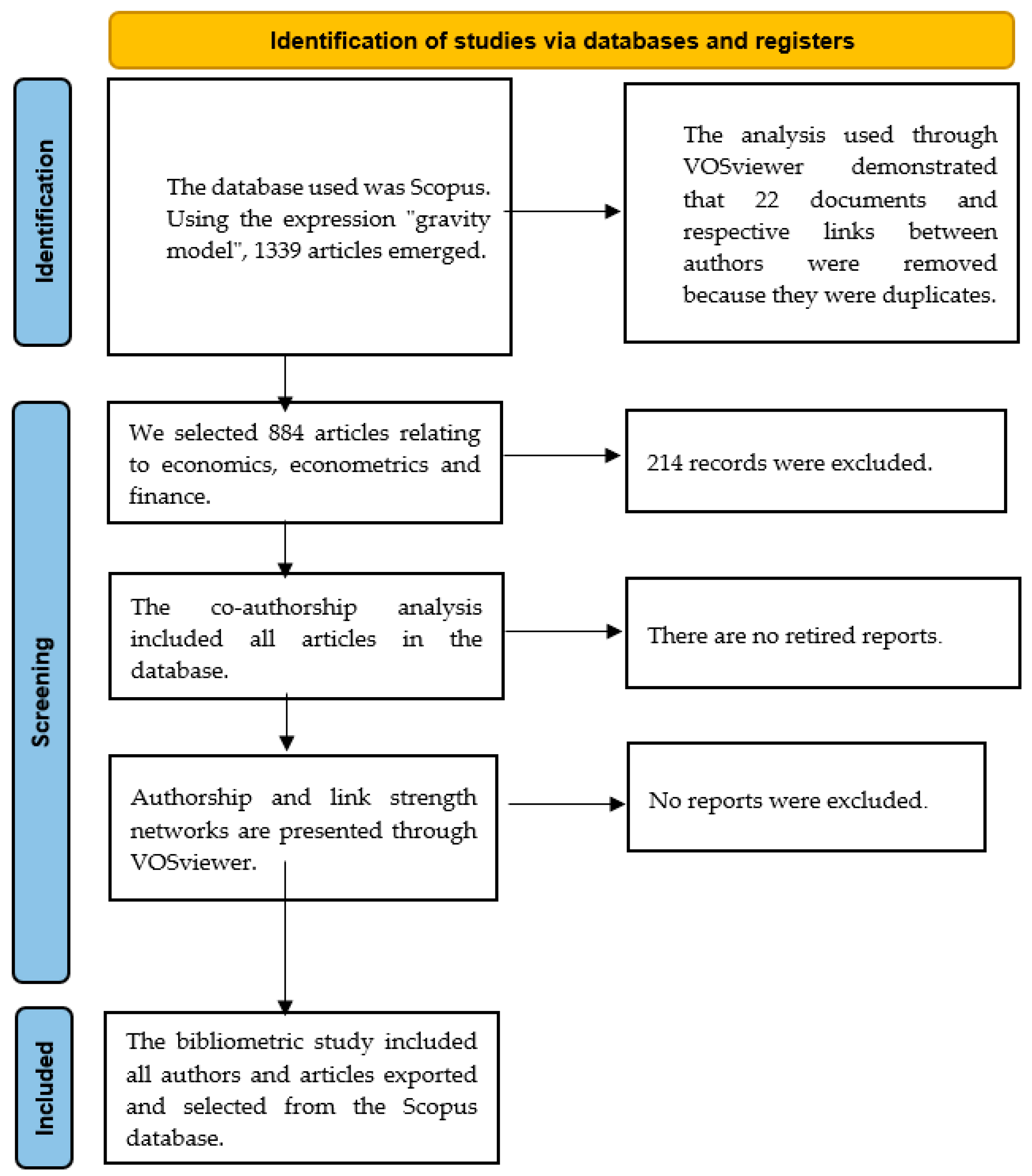
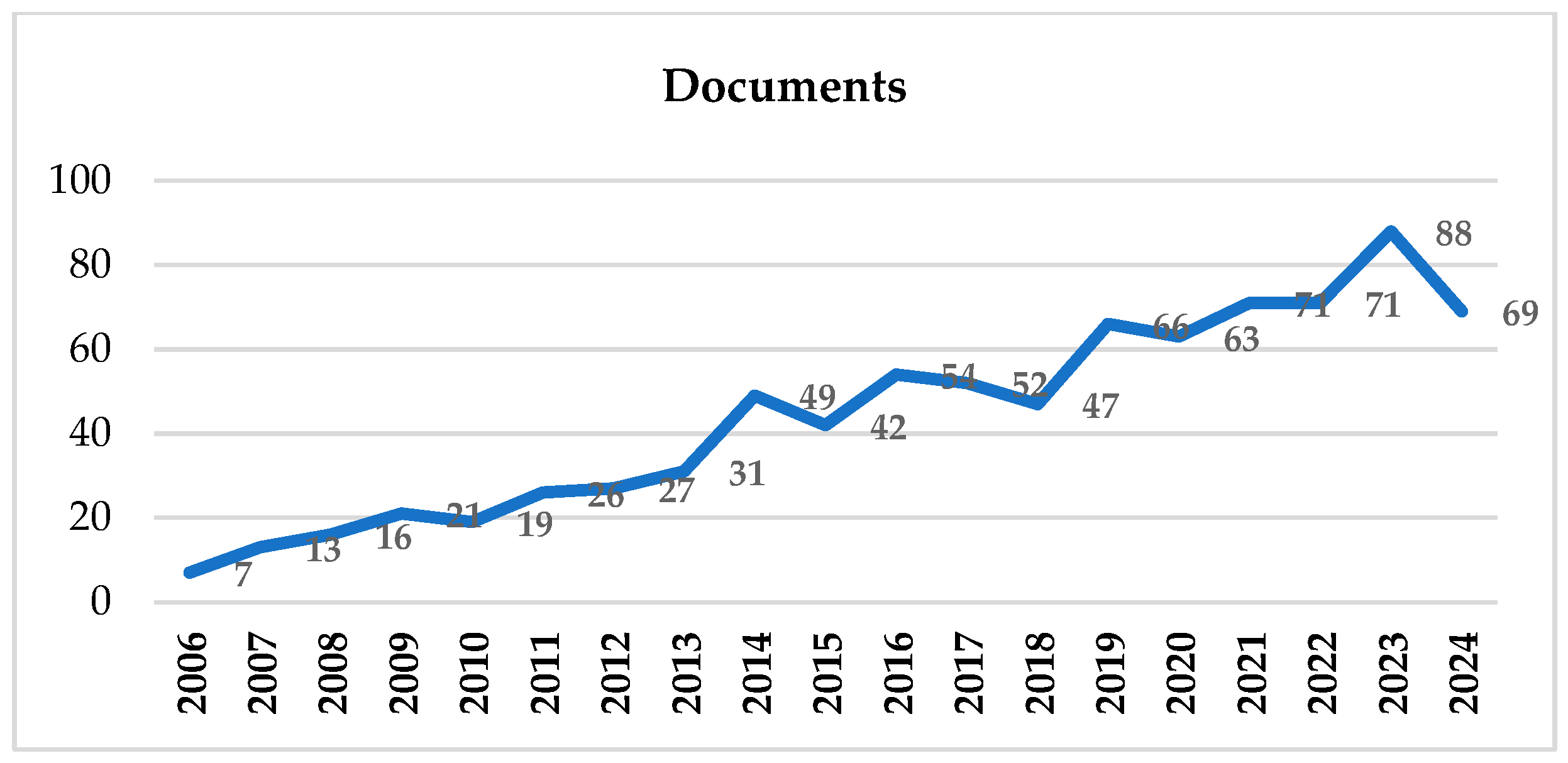
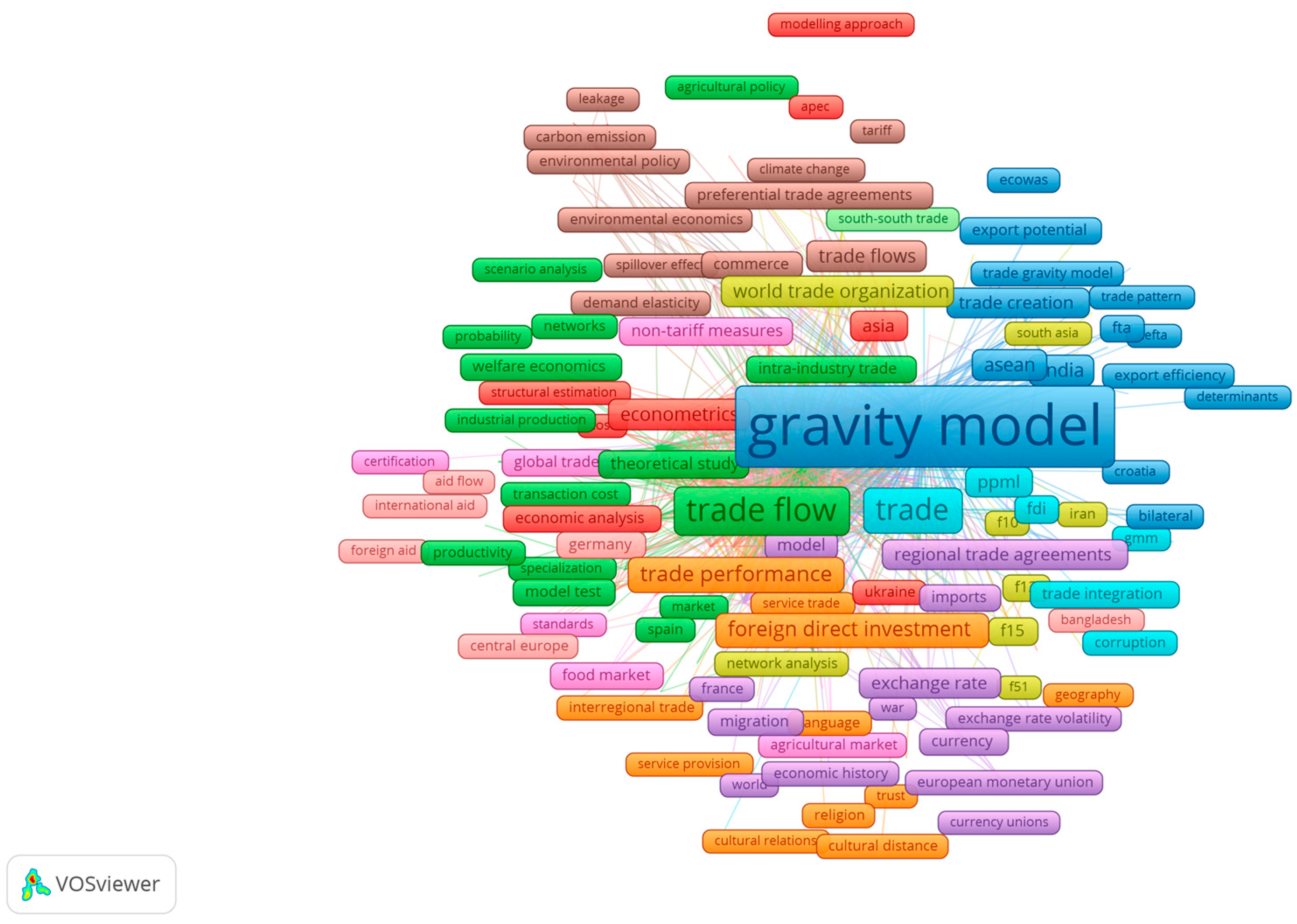
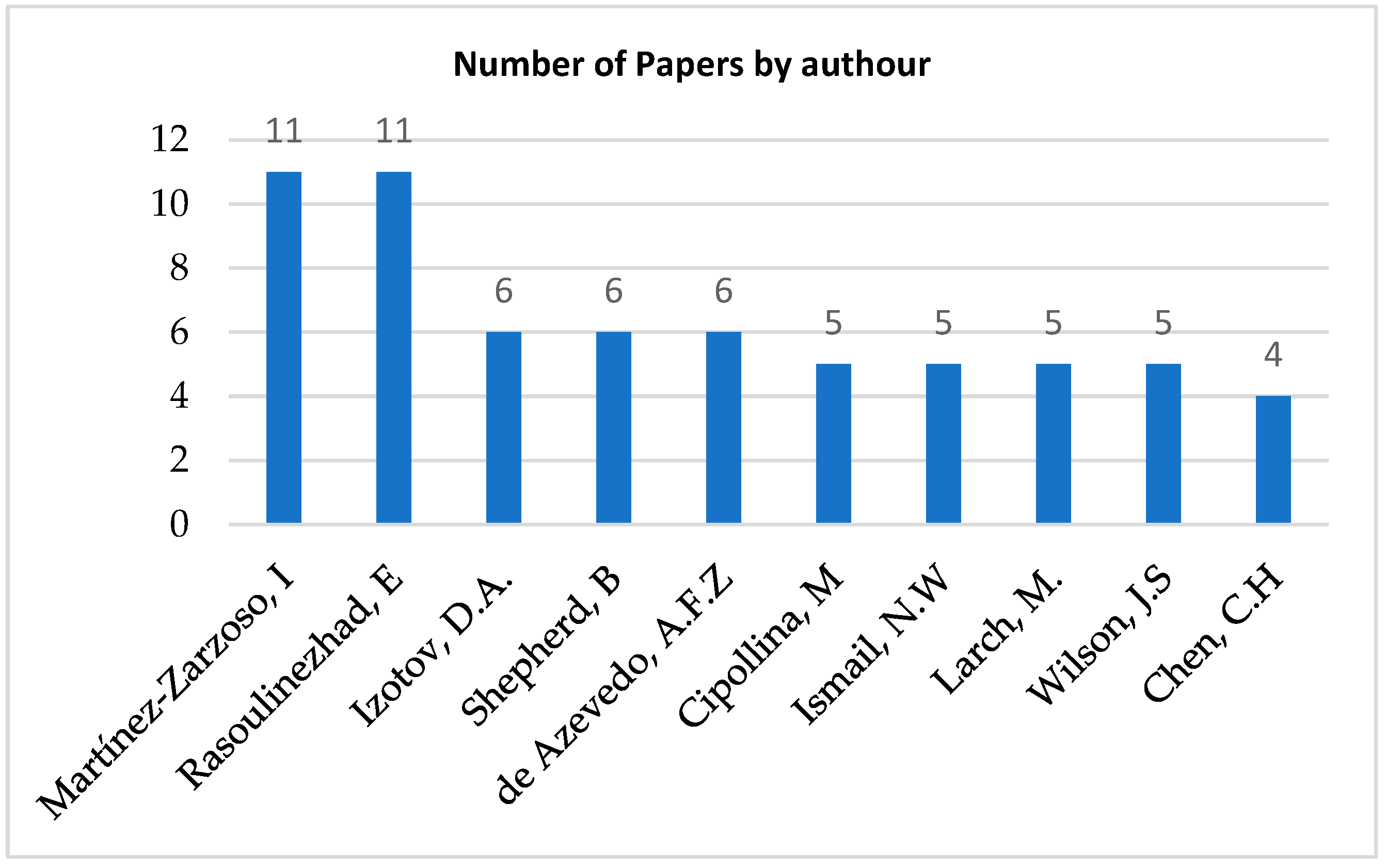
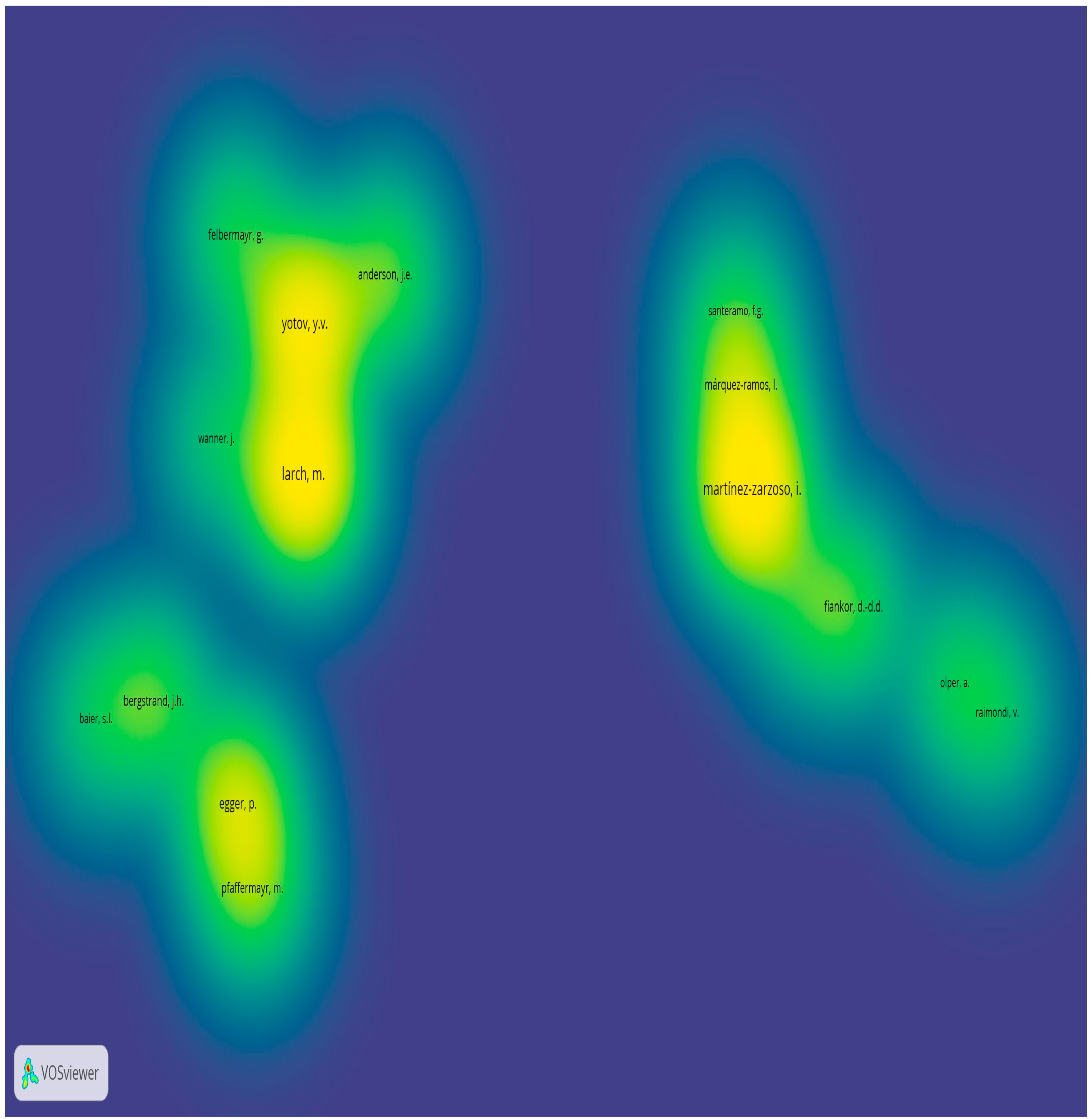
| Subject Area | Number of Papers |
|---|---|
| Economics, econometrics, and finance | 874 |
| Social science | 272 |
| Business, management, and accounting | 214 |
| Agricultural and biological sciences | 83 |
| Environmental science | 45 |
| Mathematics | 18 |
| Arts and humanities | 16 |
| Decision sciences | 13 |
| Energy | 7 |
| Computer science | 3 |
| Engineering | 3 |
| Earth and planetary sciences | 2 |
| Biochemistry, genetics, and molecular biology | 1 |
| Keywords | Occurrences |
|---|---|
| Gravity model | 874 |
| International trade | 486 |
| Export | 242 |
| Trade flow | 235 |
| Trade | 195 |
| China | 158 |
| Numerical model | 136 |
| Panel data | 127 |
| Bilateral agreement | 124 |
| Trade policy | 117 |
| Trade agreement | 109 |
| Gravity | 103 |
| Trade relations | 86 |
| Trade performance | 80 |
| Import | 80 |
| Modelling | 76 |
| Europe | 58 |
| Ranking of Country | Number of Publications |
|---|---|
| United States | 149 |
| Germany | 87 |
| China | 73 |
| Spain | 50 |
| United Kingdom | 48 |
| India | 44 |
| Italy | 42 |
| France | 37 |
| South Korea | 36 |
| Austria | 33 |
| Russian Federation | 27 |
| Japan | 26 |
| Canada | 25 |
| Malaysia | 24 |
| Turkey | 23 |
| Journals | Number of Publications | SJR 2023 (Best Quartile) |
|---|---|---|
| World Economy | 41 | Q1 = 0.94 |
| Applied Economics | 22 | Q2 = 0.59 |
| Review of World Economics | 22 | Q1 = 0.64 |
| International Trade Journal | 21 | Q3 = 0.22 |
| Economic Modelling | 18 | Q1 = 1.34 |
| Applied Economic Letters | 17 | Q3 = 0.38 |
| Economic Letters | 15 | Q2 = 0.73 |
| Journal of Economic Integration | 15 | Q2 = 0.41 |
| Open Economies Review | 15 | Q2 = 0.48 |
| Journal of Asian Economics | 12 | Q2 = 0.83 |
| Emerging Markets Finance and Trade | 11 | Q1 = 0.78 |
| Foreign Trade Review | 11 | Q2 = 0.45 |
| Economies | 10 | Q2 = 0.50 |
| International Economic Journal | 10 | Q2 = 0.29 |
| Institutions | Number of Publications |
|---|---|
| Georg-August-Universität Göttingen | 18 |
| Universidad Jaume I | 15 |
| The World Bank, USA | 15 |
| Centre for Economic Policy Research, London | 13 |
| CESifo GmbH | 12 |
| Université de Bordeaux | 10 |
| BSE—Bordeaux School of Economics | 9 |
| CNRS Centre National de la Recherche Scientifique | 8 |
| German Institute for Economic Research | 7 |
| Universidade de São Paulo | 7 |
| Universidade Federal de Vicosa | 7 |
| University of Tehran | 7 |
| Universidad Autónoma de Madrid | 7 |
| Saint Petersburg State University | 7 |
| Budapesti Corvinus Egyetem | 6 |
| Article | Authors | Journal | Methodology | Citations |
|---|---|---|---|---|
| Do free trade agreements actually increase members’ international trade? | Baier, Scott L., Bergstrand, Jeffrey H. | Journal of International Economics (2007) | Panel data (fixed effects) to evaluate FTA on trade flows. | 1326 |
| The growth of world trade: Tariffs, transport costs, and income similarity | Baier, Scott L., Bergstrand, Jeffrey H | Journal of International Economics (2001) | OLS for testing the gravity model arguments | 444 |
| A note on the proper econometric specification of the gravity equation | Egger, Peter | Economics Letters (2000) | Panel data (fixed effects versus random effects) and Hausman test | 297 |
| Interdependent preferential trade agreement memberships: An empirical analysis | Egger, Peter Larch Mario | Journal of International Economics (2008) | Panel data (probit model) considering the preference trade agreements (PTAs) | 250 |
| Terms of trade and global efficiency effects of free trade agreements, 1990–2002 | Anderson, James E. Yotov, Yoto V. | Journal of International Economics (2016) | Panel data (Poisson pseudo-maximum likelihood—PPML) for testing the efficiency of FTA | 192 |
| Economic integration agreements, border effects, and distance elasticities in the gravity equation | Bergstrand, Jeffrey H, Larch Mario, Yotov, Yoto V. | European Economic Review (2015) | Panel data (Poisson pseudo-maximum likelihood—PPML; OLS) and the arguments of gravity models | 192 |
| A panel data analysis of trade creation and trade diversion effects: The case of ASEAN-China Free Trade Area | Yang, Shanping, Martínez-Zarzoso, Inmaculada | China Economic Review (2014) | Panel data (Poisson pseudo-maximum likelihood—PPML) and the arguments of gravity models | 141 |
| Currency Unions and Trade: A PPML Re-assessment with High-dimensional Fixed Effects | Larch Mario, Wanner, Joschka, Yotov, Yoto V., Zylkin, Thomas | Oxford Bulletin of Economics and Statistics (2019) | Panel data (Poisson pseudo-maximum likelihood—PPML) and the arguments of gravity models | 124 |
| A simple solution to the distance puzzle in international trade | Yotov, Yoto V. | Economics Letters (2012) | Panel data (Poisson pseudo-maximum likelihood—PPML) and the arguments of gravity models | 119 |
| The log of gravity revisited | Martínez-Zarzoso, Inmaculada | Applied Economics (2013) | PPML estimator and gravity model | 111 |
Disclaimer/Publisher’s Note: The statements, opinions and data contained in all publications are solely those of the individual author(s) and contributor(s) and not of MDPI and/or the editor(s). MDPI and/or the editor(s) disclaim responsibility for any injury to people or property resulting from any ideas, methods, instructions or products referred to in the content. |
© 2024 by the author. Licensee MDPI, Basel, Switzerland. This article is an open access article distributed under the terms and conditions of the Creative Commons Attribution (CC BY) license (https://creativecommons.org/licenses/by/4.0/).
Share and Cite
Leitão, N.C. Gravity Model and International Trade: A Survey of the Literature. Adm. Sci. 2024, 14, 219. https://doi.org/10.3390/admsci14090219
Leitão NC. Gravity Model and International Trade: A Survey of the Literature. Administrative Sciences. 2024; 14(9):219. https://doi.org/10.3390/admsci14090219
Chicago/Turabian StyleLeitão, Nuno Carlos. 2024. "Gravity Model and International Trade: A Survey of the Literature" Administrative Sciences 14, no. 9: 219. https://doi.org/10.3390/admsci14090219
APA StyleLeitão, N. C. (2024). Gravity Model and International Trade: A Survey of the Literature. Administrative Sciences, 14(9), 219. https://doi.org/10.3390/admsci14090219





